Stay informed and empowered on your arthritis journey.
Sign up for the Arthritis Australia newsletter today and receive the latest updates, expert insights, and practical tips delivered straight to your inbox.
Joint flexibility varies widely between individuals. It depends on a number of factors including genetics, age and racial background. We are at our most flexible as babies and become less flexible with age. Many children are hypermobile (“double jointed”) in one or more joints. When this affects many joints, and is associated with pain, it is called a hypermobility syndrome.
As people normally lose flexibility through adulthood, symptoms of hypermobility may change or improve with time. For the vast majority, symptoms are manageable with simple measures.
Hypermobility can be a feature of certain genetic diseases including Ehlers-Danlos syndrome, Marfan’s syndrome and others. These are characterised by inherited changes in the collagen proteins, which form the framework that supports the ligaments, tendons and soft tissues of the body. When a specific genetic diagnosis cannot be made, the condition is called Benign Joint Hypermobility Syndrome.
People with hypermobility syndromes are more prone to sprains and strains, and may have more pain, than other people. Often this pain is prominent in the legs and feet but can affect any part of the body. Pains usually occur with use of the affected joints, for example, hand and wrist pain with long periods of hand-writing. While some people with hypermobile joints have no problems, others can have a number of associated conditions. These include:
 How is it diagnosed?
How is it diagnosed?Your child’s doctor will take a careful history and examine your child to ensure there are no other causes for your child’s pain and symptoms. Further testing or scans are rarely needed.
Loose joints need strong muscles to support them. Regular exercise and muscle conditioning is important for people with hypermobility syndromes. Activities that could result in sprains and strains, such as ballet and gymnastics, or which frequently cause pain for the child, should be avoided. Specific exercise programs, such as those recommended by experienced physiotherapists, can be very helpful. Occupational therapists can advise about writing position and technique, as well as day-to-day activities. Supportive footwear and orthotics may be helpful for some children.
Changing the types of activity your child is doing is sometimes important and may improve the pain. A physiotherapist can teach your child exercises to strengthen their muscles, advise about suitable activities and guide your child’s participation in full activity. Surgery is rarely necessary. Doing the specific exercises given by your child’s physiotherapist is important and these need to be done regularly.
Other helpful measures may include:
• Cold or heat packs
• Simple pain relief (paracetamol)
• Short periods using anti-inflammatory drugs.
As people normally lose flexibility through adulthood, symptoms of hypermobility may change or improve with time. For the vast majority, symptoms are manageable with simple measures. Sometimes it may be important to check other organs such as the heart, blood vessels and eyes when certain genetic diseases are thought to cause the hypermobility. Your doctor will advise if this is recommended for your child.
CONTACT YOUR LOCAL ARTHRITIS OFFICE FOR MORE INFORMATION AND SUPPORT SERVICES.
Websites:
Australian Rheumatology Association, American College of Rheumatology, Arthritis Foundation (US) , Arthritis Research UK
Arthritis Australia funds research and advocates to improve care, management, support and quality-of-life for people with arthritis.
Arthritis Australia advocates to government, business, industry and community leaders to improve care, management, support and quality of life for people with arthritis..
Here is our 10 steps checklist to help you live with arthritis.
Regular updates, news and research findings delivered to your inbox:
Already have an account? Login
Not registered? Create an account
Enter your email address and we'll send you an email with a link to reset your password.
The confirmation link is either expired or invalid.
An email has been sent to to confirm your details. Please click the link in the email to finish your account setup.
To finish your account setup, you must verify your email address.
Arthritis Australia is not responsible for the content or availability of linked sites.